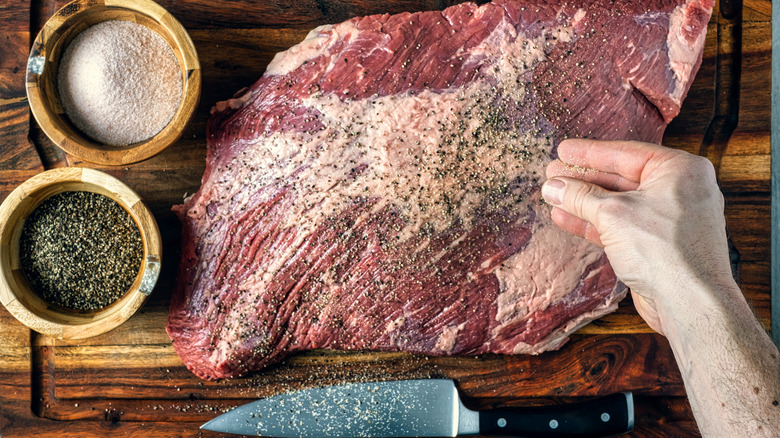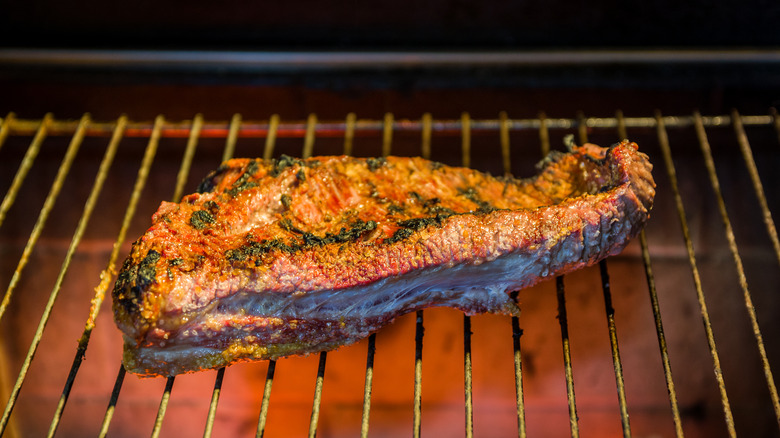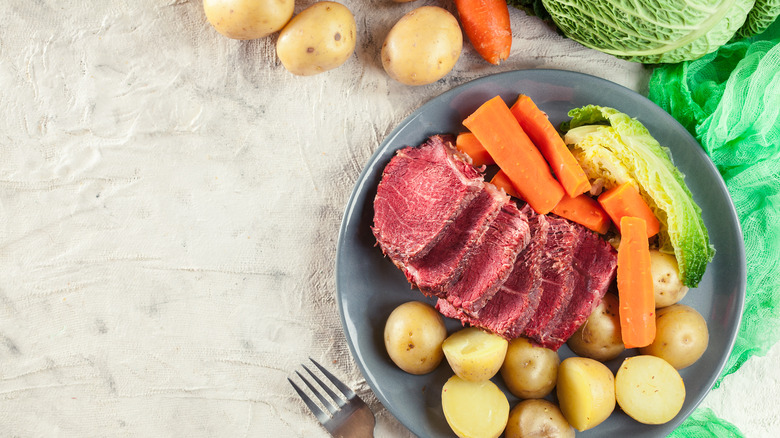Everything You Need To Know About The 2 Cuts Of Brisket
Just hearing the word brisket can make your mouth water. So many beautiful dishes are made with this humble cut. Honored by the Jewish tradition as a Passover meal, piled high on a Reuben or pastrami on rye, or as burnt ends smoked Texas style, brisket is delicious no matter how you cut it. But, did you know there are two parts to this versatile roast?
Yep, it's two for the price of one when you buy a whole brisket. The entire roast is called the packers cut. A whole brisket weighs between 10 and 16 pounds (per VeryMeaty) so is a fantastic choice for serving a crowd. But, you also have the option to break it down yourself into its two separate cuts.
The cut we know as brisket is located on the animal's chest. It's a weight-bearing muscle that leans toward chewiness if it's not cooked in a specific manner, though even here, there are options. The low and slow smoke of Texas BBQ, brined deli-style meats, or a delicate braised will all produce luscious, tender brisket.
The same collagen-rich connective tissues that can make the cut tough are rendered down by slow cooking methods (per Steak School by Stanbroke) and can eventually make your brisket tender enough to shred with two forks. So, let's consider what portion of the whole might be the best choice for your next brisket feast.
The Brisket Point
The brisket point is true to its name. The muscle tapers to a point at the end and is the fattier of the two halves. It's sometimes referred to as the deckle, but The Virtual Weber Bullet contests that the deckle is a piece of fat and meat that connects this muscle to the animal's rib cage and that it's always removed before it hits the case. They cite the IMPS, as determined by the U.S. Department of Agriculture, classifying a whole brisket as "120 Beef Brisket, Deckle-Off, Boneless" as evidence.
Brisket point is well known for the preparation of Burnt Ends. PBS Food explains that this classic Kansas City BBQ dish was a happy accident at Arthur Bryant's iconic Kansas City restaurant. As they sliced their brisket, the burnt ends of the charred point accumulated on the cutting board. Customers nibbled these smokey, fatty bits for free while they waited for their brisket sandwiches. Burnt ends became legend with the help of Calvin Trillin's praise. "I dream of those burned edges" (via Feast Magazine).
If you are in the mood to bust out your smoker and a favorite dry rub the point is an excellent option (per Food Fire Friends).
The Flat
Often the briskets offered at the market are only the flat side of the roast. The flat is the brisket's more uniform end, making it perfect for slicing. Cuisine at Home concurs, it's the cut you want for making corned beef, but we'd include pastrami as well. It's also an excellent option for hunks of corned beef and cabbage if you want to make dinner for less than twenty people. The flat is also less fatty, and since we tend to relate fat with flavor, it may have a less beefy taste than the point (per Masterclass).
Another consideration when cooking the flat is that it can quickly dry out. Though it does have a layer of fat on top, it doesn't have as much interconnective tissue as the point to keep it moist during the long cooking process required for tenderness (per Serious Eats). They suggest cooking the point with the flat to avoid dry brisket in long braises.
Also, keep in mind that the flat is the larger of the two, usually weighing 6-10 pounds with the point between 5-7 pounds. And, the size determines how much time you will spend cooking it. Though frankly, brisket is not the right choice for dinner if you're in a hurry. Brisket needs to rest for an hour (per Southern Cravings) after over 12 hours of cooking and prep! Clearly, time and patience are part of the recipe for any preparation of brisket.


